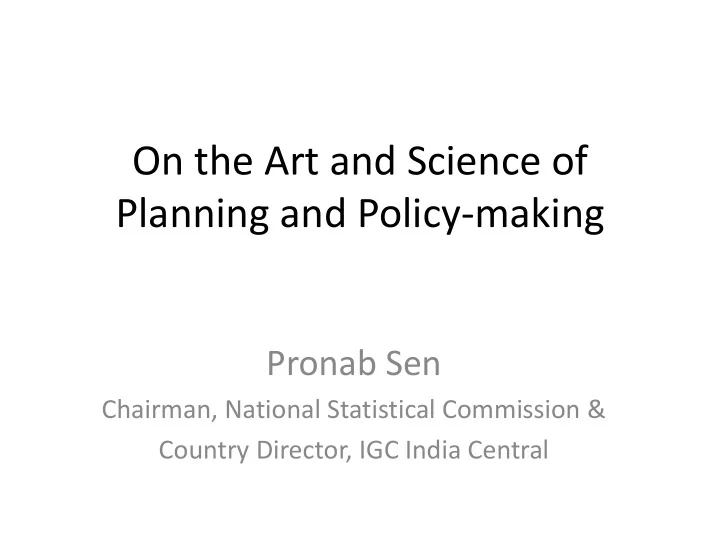

On the Art and Science of Planning and Policy-making Pronab Sen Chairman, National Statistical Commission & Country Director, IGC India Central
Stages in Policy-making 1. Identification of issue 2. Diagnosis of issue 3. Intervention to address issue i. Type of intervention ii. Design of intervention 4. Implementation and Monitoring 5. Evaluation and Course Correction
Identification: The Art • Issues are thrown up from diverse sources: politicians, civil society, academics, personal observations, international agencies, etc: • Ultimately filtered through the political system • Civil servants can influence, but not determine the issues to be taken up • Usually issues are not well defined. The science lies in defining properly and laying out the dimensions
Identification: The Science • Usually requires only descriptive statistics • Measures of central tendency: mean, mode, median, etc: • Measures of dispersion: standard deviation; coefficient of variation; skewness; kurtosis, etc: • Measures of distribution: Gini coefficient; fractal ratios; etc:
Diagnosis: The Art • Initial identification almost always comes with a diagnosis. • “ Gut feeling ”, sectional interests or pre-conceived ideas are usually the basis of these diagnoses. These have to be frequently overcome. • Proper identification is the first and most important step: diagnosis is sometimes self- evident. In most other cases, further analysis is required. • The art is to determine which applies.
Diagnosis: The Science • In non-obvious cases, it is necessary to identify possible alternative causes. • Evaluating alternatives requires complex analysis and wide range of data • Causality tests desirable, but data may not permit • New econometric methods (regression discontinuity) available, not widely applied
Intervention • Two main stages in developing the appropriate intervention for addressing an issue: a) Deciding the type of intervention needed b) Designing the intervention • Two main types of interventions: a) Policy b) Programme or scheme
Type of Intervention • Decision highly dependent on diagnosis. For issues with multiple dimensions more than one intervention may be needed • Policy suitable when desired behaviour changes happen if environment is changed • Programmes suitable in other cases: i.e. when behaviour change is unlikely to solve problem and direct public action is needed • This decision is coloured by a preference for schemes.
Design of Policy: Largely Science • Nature of Policy intervention broadly obtainable from analysis done in determining its suitabilility • Actual design involves assessment of side- effects • This requires understanding of theory and institutional behaviour, and can involve complex modelling (CGE models for example)
Design of Programmes: Largely Art • Programme design much more complex • Requires micro human behavioural knowledge • Experience and experimentation are key • New techniques such as randomised control trials (RCT) useful, but care needs to be taken • In all cases the underlying theory must be carefully documented
Implementation and Monitoring • Understanding of institutional structures essential in all cases • For policy, transmission channels in terms of intermediate and final variables be specified • For programmes, by and large, straightforward management information systems (MIS) suffice • However, really good monitoring systems should provide well-defined measurable relations between input, process and output variables
Evaluation and Course Correction • Good evaluation should be built in at the design stage • Measuring and assessing the change in outcome variables is at the core, but is not enough • Must always be able to assess the appropriateness of the underlying theory
Thank you
Recommend
More recommend